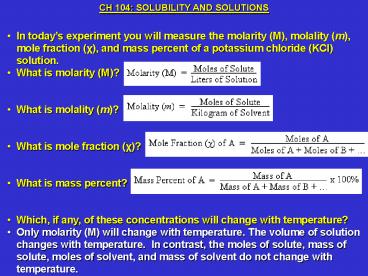CH 104: SOLUBILITY AND SOLUTIONS - PowerPoint PPT Presentation
Title:
CH 104: SOLUBILITY AND SOLUTIONS
Description:
CH 104: SOLUBILITY AND SOLUTIONS In today s experiment you will measure the molarity (M), molality (m), mole fraction ( ), and mass percent of a potassium chloride ... – PowerPoint PPT presentation
Number of Views:106
Avg rating:3.0/5.0
Title: CH 104: SOLUBILITY AND SOLUTIONS
1
CH 104 SOLUBILITY AND SOLUTIONS
- In todays experiment you will measure the
molarity (M), molality (m), mole fraction (?),
and mass percent of a potassium chloride (KCl)
solution. - What is molarity (M)?
- What is molality (m)?
- What is mole fraction (?)?
- What is mass percent?
- Which, if any, of these concentrations will
change with temperature? - Only molarity (M) will change with temperature.
The volume of solution changes with temperature.
In contrast, the moles of solute, mass of solute,
moles of solvent, and mass of solvent do not
change with temperature.
2
SOLUBILITY AND SOLUTIONS
- A solution is made by dissolving 1.370 grams (g)
of KCl in 100.0 g of water. Its final volume is
100.9 milliliters (mL). What are the molarity
(M), molality (m), mole fraction of KCl (?KCl),
and mass percent of KCl for this solution?
You just calculated 4 different concentrations of
KCl for the same solution. Each has its
advantages and disadvantages.
3
SOLUBILITY AND SOLUTIONS
- The terms insoluble, slightly soluble, soluble,
and very soluble describe the relative solubility
of a substance in a solvent. - In todays experiment you will use these terms to
compare the solubilities of sodium carbonate
(Na2CO3), naphthalene (C10H8), and calcium
carbonate (CaCO3) in 2 different solvents. - The first solvent is water (H2O) and the second
solvent is cyclohexane (C6H12). Water is
relatively polar and C6H12 is relatively
nonpolar. - Like dissolves like. That is, polar solvents
tend to dissolve polar solutes. And nonpolar
solvents tend to dissolve nonpolar solutes.
4
SOLUBILITY AND SOLUTIONS
- Describe the electrostatics for the dissolution
of an ionic crystal in water. - Water dipoles cluster around ions at the surface
of the crystal. The negative ends of these
dipoles are oriented toward the positive ions
(cations). In contrast, the positive ends of
these dipoles are oriented toward the negative
ions (anions). The solid will dissolve if these
ion-dipole forces are greater than the interionic
attractions within the crystal. Moreover, these
ion-dipole forces persist in the solution. An
ion is hydrated when it is surrounded by water
molecules.
5
SOLUBILITY AND SOLUTIONS
- The terms immiscible, partially miscible, and
infinitely miscible describe the relative
solubility of a liquid solute in a liquid
solvent. - In todays experiment you will use these terms to
compare the miscibility of water (H2O),
2-propanol (isopropyl alcohol, CH3CHOHCH3), and
cyclohexane (C6H12). Water is the most polar and
C6H12 is the least polar. Why? - Water has 2 hydrogens bonded to oxygen.
CH3CHOHCH3 has 1 hydrogen bonded to oxygen. And
C6H12 has no hydrogens bonded to oxygen. These
OH groups are polar and form hydrogen bonds with
other molecules. - The hydrogen bonds of water are shown as dotted
lines.
6
SOLUBILITY AND SOLUTIONS
- A corollary to like dissolves like is oil and
water dont mix. - Oil and water in a separatory funnel.
7
SOLUBILITY AND SOLUTIONS
- Why doesnt oil and water mix?
- The hydrogen bonds of water are shown as dotted
lines. - Water is an associated liquid that is, adjacent
water molecules are held together by relatively
strong hydrogen bonds. In contrast, oils and
other nonpolar liquid are held together by
relatively weak intermolecular forces.
Therefore, the attraction between oil and water
molecules is not strong enough for the oil to
break the hydrogen bonds of water and dissolve
into the water.
8
SAFETY
- Do NOT use cyclohexane (C6H12) or 2-propanol
(CH3CHOHCH3) until all the Bunsen burners in the
laboratory are extinguished. Treat these
compounds as if they were gasoline. They are
extremely flammable. - Wear your goggles at all times.
- Your laboratory manual has an extensive list of
safety procedures. Read and understand this
section. - Ask your instructor if you ever have any
questions about safety.
9
SOURCES
- McMurry, J., R.C. Fay. 2004. Chemistry, 4th ed.
Upper Saddle River, NJ Prentice Hall. - Petrucci, R.H. 1985. General Chemistry Principles
and Modern Applications, 4th ed. New York, NY
Macmillan Publishing Company. - Wright, A.E. 2006. NOAA Ocean Explorer.
Available http//www.oceanexplorer.noaa.gov/explo
rations/02sab/background/products/products.html
accessed 13 December 2006.































